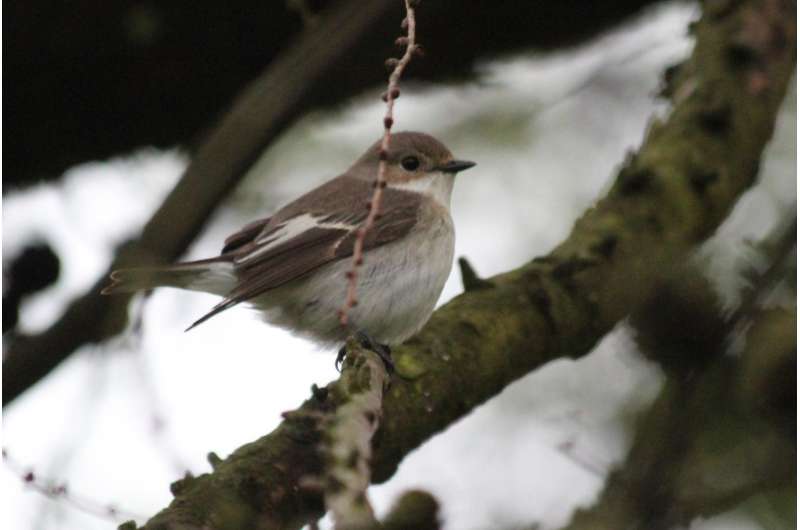April 18, 2016 report
Study shows songbird travels nonstop for migration over Sahara

(Phys.org)—A pair of researchers, both with the University of Groningen in The Netherlands, has found that a certain songbird flies for 40 to 60 hours straight when it crosses the Sahara Desert as part of its diurnal migration pattern. In their paper published in Biology Letters, Janne Ouwehand and Christiaan Both describe attaching light and temperature sensors to several of the birds, retrieving the sensors and what the data revealed.
As the researchers note, over two billion songbirds cross the Sahara each year as part of their migration path, but because of their small size and huge numbers it has been nearly impossible to tell if the birds stop along the way or fly straight through—to date there has been conflicting information, due to an inability to connect hard data with actual bird sightings. In this latest effort, the researchers took a new approach, attaching tiny loggers to 80 pied flycatchers captured and released from a breeding ground in the Netherlands. The loggers recorded light and temperature readings every five to ten minutes over the entire course of a migratory trip. The birds were recaptured when they returned to the breeding grounds, a year later allowing for the data to be retrieved from the loggers.
While it might seem like not much could be learned from such simple measurements, the team explains that putting the data together allowed for creating light curves, which allowed for calculating day length and from that approximate latitude. They were also able to calculate longitude by establishing the midpoint of the days and nights. In their study, the researchers report that they were able to retrieve 27 of the loggers, of which 15 contained useful data for both spring and fall migrations. They report also that some of the data was difficult to read, because the songbirds sometimes hide in dark places during daylight hours. But they also noted that on two occasions each, there were periods of smooth, clear data, suggesting that the birds were flying non-stop, for periods lasting from 40 to 60 hours.
The finding, the team reports, is surprising, because it suggests that for large parts of their journey over the Sahara, the birds were flying in broad daylight—a time thought to be too hot for such travel. The team also found that the birds took a different route home, spending much of their long flight time, flying over the ocean, instead of the desert.
More information: Janne Ouwehand et al. Alternate non-stop migration strategies of pied flycatchers to cross the Sahara desert, Biology Letters (2016). DOI: 10.1098/rsbl.2015.1060
Abstract
Each year more than two billion songbirds cross the Sahara, but how they perform this formidable task is largely unknown. Using geolocation tracks from 27 pied flycatchers, a nocturnally migrating passerine, we show that most birds made diurnal flights in both autumn and spring. These diurnal flights were estimated to be part of non-stop flights of mostly 40–60 h. In spring, birds flew across the Sahara, while autumn migration probably circumpassed part of the desert, through a long oversea flight. Our data contradict claims that passerines cross the Sahara by intermittent flight and daytime resting. The frequent occurrence of long non-stop flights to cross the desert shows migrants' physiological abilities and poses the question why this would not be the general migration strategy to cross the Sahara.
Journal information: Biology Letters
© 2016 Phys.org


















